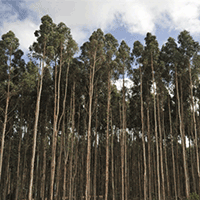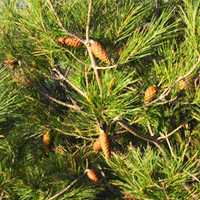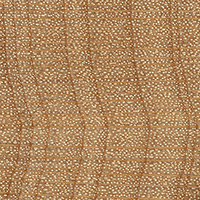Black locust (Robinia pseudoacacia L.) is a multipurpose tree species native to North America commonly planted worldwide for its resistant and durable wood, rapid growth, site tolerance, honey production, and other qualities. However, caution is warranted when planting the species outside its native range due to its potential invasiveness with respect to the native flora. Many countries, particularly Hungary and China, have been conducting forestry research on black locust for decades to increase black locust yields, nectar production, and stem quality. The main breeding objectives, such as fast growth, superior trunk quality or higher nectar production, have already been achieved. Existing reviews on this tree species do not cover the whole research history of breeding, making a comprehensive review increasingly critical to identify research gaps, trends, and drawbacks. The present study offers a systematic analysis of nearly 100 papers spanning the last century and the most recent research on black locust improvement. This study also includes a detailed summary of the available cultivars and clone selections worldwide.
Keywords
, , ,
Citation
Ábri T, Cseke K, Keserü Z, Porcsin A, Szabó FM, Rédei K (2023). Breeding and improvement of black locust (Robinia pseudoacacia L.) with a special focus on Hungary: a review. iForest 16: 290-298. - doi: 10.3832/ifor4254-016
Academic Editor
Pierluigi Paris
Paper history
Received: Oct 28, 2022
Accepted: Aug 16, 2023
First online: Oct 28, 2023
Publication Date: Oct 31, 2023
Publication Time: 2.43 months
© SISEF - The Italian Society of Silviculture and Forest Ecology 2023
Open Access
This article is distributed under the terms of the Creative Commons Attribution-Non Commercial 4.0 International (https://creativecommons.org/licenses/by-nc/4.0/), which permits unrestricted use, distribution, and reproduction in any medium, provided you give appropriate credit to the original author(s) and the source, provide a link to the Creative Commons license, and indicate if changes were made.

Breakdown by View Type
(Waiting for server response...)
Article Usage
Total Article Views: 24309
(from publication date up to now)
Breakdown by View Type
HTML Page Views: 19685
Abstract Page Views: 2516
PDF Downloads: 1684
Citation/Reference Downloads: 6
XML Downloads: 418
Web Metrics
Days since publication: 778
Overall contacts: 24309
Avg. contacts per week: 218.72
Article Citations
Article citations are based on data periodically collected from the Clarivate Web of Science web site
(last update: Mar 2025)
Total number of cites (since 2023): 2
Average cites per year: 0.67
Publication Metrics
by Dimensions ©
Articles citing this article
List of the papers citing this article based on CrossRef Cited-by.
(1)
Ábri T, Keserü Zs, Rásó J, Rédei K (2021)Stand structure and growth of
Robinia pseudoacacia ’Jászkiséri’ black locust. Journal of Forest Science 67: 489-497.
CrossRef |
Gscholar
(2)
Ábri T, Keserü Zs, Borovics A, Rédei K, Csajbók J (2022)Comparison of juvenile, drought tolerant Black locust (
Robinia pseudoacacia L.) clones with regard to plant physiology and growth characteristics in Eastern Hungary: early evaluation. Forests 13 (2): 292.
CrossRef |
Gscholar
(3)
Aravanopoulos FA (2010)Breeding of fast growing forest tree species for biomass production in Greece. Biomass and Bioenergy 34 (11): 1531-1537.
CrossRef |
Gscholar
(4)
Barrett RP, Mebrahtu T, Hannover JW (1990)Black locust: a multi-purpose tree species for temperate climates. In: “Advances in new crops” (Janick J, Simon JE eds). Timber Press, Portland, Oregon, USA, pp. 278-283.
Gscholar
(5)
Bartha D, Csiszár A, Zsigmond V (2008)Black locust (
Robinia pseudoacacia L.). In: “The Most Important Invasive Plants in Hungary” (Botta-Dukat Z, Balogh L eds). Institute of Ecology and Botany, Hungarian Academy of Sciences, Vácrátót, Hungary, pp. 63-76.
Gscholar
(6)
Borde B (2018)Silviculture of black locust trees producing timber. Forêt-Entreprise 241: 12-19.
Gscholar
(7)
Brus R, Pötzelsberger E, Lapin K, Brundu G, Orazio C, Straigyte L, Hasenauer H (2019)Extent, distribution and origin of non-native forest tree species in Europe. Scandinavian Journal of Forest Research 34 (7): 533-544.
CrossRef |
Gscholar
(8)
Budäu R, Timofte AI (2015)Observations and measurements of morphological traits in two varieties of black locust:
Robinia pseudoacacia var.
rectissima and var.
oltenica. In: Proceedings of the Biennial International Symposium “Forest and Sustainable Development”. Brasov (Romania) 24-25 Oct 2014. Transilvania University Press, Brasov, Romania, pp. 9-14.
Gscholar
(9)
Campagnaro T, Nascimbene J, Tasinazzo S, Trentanovi G, Sitzia T (2018)Exploring patterns, drivers and structure of plant community composition in alien
Robinia pseudoacacia secondary woodlands. iForest 11: 586-593.
CrossRef |
Gscholar
(10)
Cierjacks A, Kowarik I, Joshi J, Hempel S, Ristow M, Von Der Lippe M, Weber E (2013)Biological flora of the British Isles:
Robinia pseudoacacia. Journal of Ecology 101: 1623-1640.
CrossRef |
Gscholar
(11)
Ciuvat AL, Abrudan IV, Ciuvat CG, Marcu C, Lorent A, Dinca L, Szilard B (2022)Black Locust (
Robinia pseudoacacia L.) in Romanian forestry. Diversity 14 (10): 780.
CrossRef |
Gscholar
(12)
Corneanu M, Corneanu GC, Illiev I, Danci O, Sefanescu I, Popa M (2010)Micropropagation of
Robinia pesudoacacia var.
oltenica selected stress resistant clones on media with deuterium depleted water. Journal of Horticulture, Forestry and Biotechnology 14 (1): 141-144.
Gscholar
(13)
Crosti R, Agrillo E, Ciccarese L, Guarino R, Paris P, Testi A (2016)Assessing escapes from short rotation plantations of the invasive species
Robinia pseudoacacia L. in Mediterranean ecosystems: a study in central Italy. iForest 9 (5): 822-828.
CrossRef |
Gscholar
(14)
DeGomez T, Wagner MR (2001)Culture and use of black locust. HortTechnology 11: 279-288.
CrossRef |
Gscholar
(15)
Demené JM, Merzeau D (2007)Le robinier faux acacia, Historique et caractéristiques biologiques. [History and biological characteristics of black locust]. Forêt-Entreprise 177: 10-12. [In French]
Gscholar
(16)
Dini-Papanastasi O, Panetsos CP (2000)Relation between growth and morphological traits and genetic parameters of
Robinia pseudoacacia var.
monophylla D.C. in northern Greece. Silvae Genetica 49 (1): 37-44.
Gscholar
(17)
Dini-Papanastasi O, Papachristou TG (1999)Selection of
Robinia pseudoacacia var.
monophylla for increased feeding value in the Mediterranean environment. In: Proceedings of the “International Symposium Grasslands and Woody Plants in Europe” (Papanastasis V, Frame J, Nastis A eds). Thessaloniki (Greece) 27-29 May 1999. European Grassland Federation, vol. 4, Grassland Science in Europe, pp. 51-56.
Gscholar
(18)
Dini-Papanastasi O (2004)Contribution to the selection of productive progenies of
Robinia pesudoacacia var.
monophylla Carr. from young plantations in northern Greece. Forest Genetics 11 (2): 113-123.
Gscholar
(19)
Dini-Papanastasi O (2008)Effects of clonal selection on biomass production and quality in Robinia pseudoacacia var. monophylla Carr. Forest Ecology and Management 256 (4): 849-854.
CrossRef |
Gscholar
(20)
Dini-Papanastasi O, Kostopoulou P, Radoglou K (2012)Effects of seed origin, growing medium and mini-plug density on early growth and quality of black locust (
Robinia pseudoacacia L.) seedlings. Journal of Forest Science 58 (1): 8-20.
CrossRef |
Gscholar
(21)
Dong L, Sun Y, Zhao K, Zhang J, Zhang Y, Li X, Xun S, Zhang J, Wang S, Li Y (2019)Development and Application of EST-SSR Markers for DNA fingerprinting and genetic diversity analysis of the main cultivars of Black Locust (
Robinia pseudoacacia L.) in China. Forests 10 (8): 644.
CrossRef |
Gscholar
(22)
Dyderski MK, Paz S, Frelich LE, Jagodzinski AM (2017)How much does climate change threaten European forest tree species distributions? Global Change Biology 24 (3): 1150-1163.
CrossRef |
Gscholar
(23)
Enescu CM, Danescu A (2013)Black locust (
Robinia pseudoacacia L.) - An invasive neophyte in the conventional land reclamation flora in Romania. Bulletin of the Transilvania University of Brasov, Series II - Forestry, Wood Industry, Agricultural Food Engineering 6 (55): 23-30.
Gscholar
(24)
Ewald D, Ulrich K, Naujoks G, SchröDer MB (2009)Induction of tetraploid poplar and black locust plants using colchicine: chloroplast number as an early marker for selecting polyploids
in vitro. Plant Cell Tissue and Organ Culture 99: 353-357.
CrossRef |
Gscholar
(25)
Facciotto G, Nervo G, Vietto L (2009)Biomass production with fast growing woody plants for energy purposes in Italy. In: Proceedings of the International Scientific Conference “Forestry in Achieving Millennium Goals” (Orlovic S ed). Novi Sad (Serbia) 13-15 Nov 2008. Institute of Lowland Forestry and Environment, Novi Sad, Serbia, pp. 105-110.
Gscholar
(26)
Fleischmann R (1933)Beiträge zur Robinienzüchtung [Contributions to breeding of black locust]. Der Zuchter 5: 85-88. - [in German] doi:
CrossRef |
Gscholar
(27)
Giuliani C, Lazzaro L, Lippi MM, Calamassi R, Foggi B (2015)Temperature-related effects on the germination capacity of black locust (
Robinia pseudoacacia L., Fabaceae) seeds. Folia Geobotanica 50: 275-282.
CrossRef |
Gscholar
(28)
Giulietti V (2016)Robinia (
Robinia pseudoacacia L.). In: “Le biomasse lignocellulosiche” [Lignocellulosic biomass] (Bonari E, Maracchi G eds). Firenze University Press, Firenze, Italy, pp. 163-170. [in Italian]
Gscholar
(29)
Glen HF (2002)Cultivated plants of Southern Africa: botanical names, common names, origins, literature. Jacana Media, Johannesburg, Republic of South Africa, pp. 428.
Gscholar
(30)
Guo Q, Wang JX, Su LZ, Lv W, Sun YH, Li Y (2017)Development and evaluation of a novel set of EST-SSR markers based on transcriptome sequences of Black Locust (
Robinia pseudoacacia L.). Genes 8 (7): 177.
CrossRef |
Gscholar
(31)
Guo Q, Cao S, Dong L, Li X, Zhang J, Zhang Y, Zhang Z, Sun Y, Long C, Fan Y, Han C, Han P, Liu X, Li Y (2022a)Genetic diversity and population structure of
Robinia pseudoacacia from six improved variety bases in China as revealed by simple sequence repeat markers. Journal of Forestry Research 33: 611-621.
CrossRef |
Gscholar
(32)
Guo Q, Sun Y, Zhang J, Li Y (2022b)Variation of phenotypic and physiological traits of
Robinia pseudoacacia L. from 20 provenances. PLoS One 17 (1): e0262278.
CrossRef |
Gscholar
(33)
Hanover JW, Mebrathu T, Bloese P (1991)Genetic improvement of black locust: a prime agroforestry species. The Forestry Chronicle 67 (3): 227-231.
CrossRef |
Gscholar
(34)
Hopp H (1941)Methods of distinguishing between the shipmast and common forms of Black locust on Long Island, NY. Technical Bulletin 742, USDA, Washington, DC, USA, pp. 24.
Online |
Gscholar
(35)
Hu S, Jiao J, Kou M, Wang N, García-Fayos P, Liu S (2021)Quantifying the effects of
Robinia pseudoacacia afforestation on plant community structure from a functional perspective: new prospects for management practices on the hilly and gullied Loess Plateau, China. Science of the Total Environment 773: 144878.
CrossRef |
Gscholar
(36)
Huntley JC (1990)Robinia pseudoacacia L. - Black locust. In: “Silvics of North America”, vol. 2 (Burns RM, Honkala BH eds). Hardwoods Agriculture Handbook no. 654, USDA Forest Service, Washington, DC, USA, pp. 755-761.
Gscholar
(37)
Járó Z, Lengyel G (1988)Stand establishment. In: “The Black Locust” (Keresztesi B ed). Akadémiai Kiadó, Budapest, Hungary, pp. 87-115.
Gscholar
(38)
Kalmukov K (2011)Improvement of the black locust stands in Bulgaria. In: Proceedings of the “Biennial International Symposium, Forest and Sustainable Development” (Malek S, Jasik M eds). Brasov (Romania) 15-16 Oct 2010. Transilvania University Press, Brasov, Romania, pp. 41-46.
Gscholar
(39)
Keresztesi B (1983)Breeding and cultivation of black locust,
Robinia pseudoacacia, in Hungary. Forest Ecology and Management 6: 217-244.
CrossRef |
Gscholar
(40)
Keresztesi B (1988)The black locust. Akadémiai Kiadó, Budapest, Hungary, pp. 197.
Gscholar
(41)
Keserü Z, Borovics A, Ábri T, Rédei K, Lee IH, Lim H (2021)Growing of Black locust (
Robinia pseudoacacia L.) candidate cultivars on arid sandy site. Acta Silvatica et Lignaria Hungarica 17: 51-61.
CrossRef |
Gscholar
(42)
Klisz M, Ukalska J, Wojda T, Jastrzebowski S, Mionskowski M, Szyp-Borowska I (2014)Radial growth of selected stand of black locust in Poland. Annals of Warsaw University of Life Sciences - SGGW, Forestry and Wood Technology 85: 123-130.
Gscholar
(43)
Kopecky F (1966)Indukált nyár és akác poliploidok jelentosége a gyors növésü fafajok nemesítésében. [The importance of induced poplar and black locust polyploids in the breeding of fast-growing tree species]. Erdészeti Kutatások 62: 161-175. [in Hungarian]
Gscholar
(44)
Kraszkiewicz A (2021)Productivity of Black locust (
Robinia pseudoacacia L.) grown on a varying habitats in Southeastern Poland. Forests 12 (4): 470.
CrossRef |
Gscholar
(45)
Kutnar L, Kobler A (2013)Sedanje stanje razširjenosti robinije (
Robinia pseudoacacia L.) v Sloveniji in napovedi za prihodnost. [The current state of distribution of black locust (
Robinia pseudoacacia L.) in Slovenia and predictions for the future]. Acta Silvae et Ligni 102: 21-30 [in Slovenian]
CrossRef |
Gscholar
(46)
Lee JK, Sohn JH, Rédei K, Yun HY (2007)Selection of early and late flowering Robinia pseudoacacia from domesticated and introduced cultivars in Korea and prediction of flowering period by accumulated temperature. Journal of Korean Forestry Society 96 (2): 170-177.
Gscholar
(47)
Lian C, Hogetsu T (2002)Development of microsatellite markers in black locust (
Robinia pseudoacacia) using a dual-suppression-PCR technique. Molecular Ecology Resources 2 (3): 211-213.
CrossRef |
Gscholar
(48)
Liesebach H, Schneck V (2012)Chloroplast DNA variation in planted and natural regenerated stands of black locust (
Robinia pseudoacacia L.). Silvae Genetica 61 (1-2): 27-35.
CrossRef |
Gscholar
(49)
Liesebach H, Yang MS, Schneck V (2004)Genetic diversity and differentiation in a black locust (
Robinia pseudoacacia L.) progeny test. International Journal of Forest Genetics 11: 151-161.
Gscholar
(50)
Lu N, Dai L, Wu B, Zhang Y, Luo Z, Xun S, Sun Y, Li Y (2015)A preliminary study on the crossability in Robinia pseudoacacia L.. Euphytica 206: 555-566.
CrossRef |
Gscholar
(51)
Luo Q, Peng M, Zhang X, Lei P, Ji X, Chow W, Meng F, Sun G (2017)Comparative mitochondrial proteomic, physiological, biochemical and ultrastructural profiling reveal factors underpinning salt tolerance in tetraploid black locust (
Robinia pseudoacacia L.). BMC Genomics 18: 648.
CrossRef |
Gscholar
(52)
Maltoni A, Tani A, Mariotti B (2012)La gestione della robinia in Toscana: la gestione dei popolamenti, l’impiego in impianti specializzati, il controllo della diffusione [The management of the black locust in Tuscany: the management of stands, the use in specialized plants, the control of the spread]. Regione Toscana, Firenze, Italy, pp. 167. [in Italian]
Gscholar
(53)
Mantovani D, Veste M, Freese D (2014)Effects of drought frequency on growth performance and transpiration of young black locust (
Robinia pseudoacacia L.). International Journal of Forestry Research 2014: 821891.
CrossRef |
Gscholar
(54)
Mantovani D, Veste M, Böhm C, Vignudelli M, Freese D (2015)Spatial and temporal variation of drought impact on black locust (
Robinia pseudoacacia L.) water status and growth. iForest 8 (6): 743-747.
CrossRef |
Gscholar
(55)
McAlister RH (1971)Black locust (
Robinia pseudoacacia L.). USDA Forest Service, Washington, DC, USA, pp. 6.
Online |
Gscholar
(56)
Miller RO, Bloese PD, Hanover JW (1987)Black locust: a superior short-rotation intensive culture species for biomass production in the Lake States. In: Proceedings of the “11th Annual Meeting on Energy from Biomass and Wastes”. Orlando (FL, USA) 16 Mar 1987. Institute of Gas Technology, Orlando, FL, USA, pp. 23.
Gscholar
(57)
Mishima K, Hirao T, Urano S, Watanabe A, Takata K (2009)Isolation and characterization of microsatellite markers from
Robinia pseudoacacia L. Molecular Ecology Resources 9 (3): 850-852.
CrossRef |
Gscholar
(58)
Neophytou C, Konnert M (2018)Technical guidelines for molecular genetic analysis in non-native forest tree species of Europe (1st ed). Silva Slovenica 160, SciVie - Slovenian Forestry Institute, Ljubljana, Slovenia, pp. 162.
CrossRef |
Gscholar
(59)
NFCSO (2021)Official list of state-approved cultivars and candidate cultivars for forestry and energy plantation purposes. National Food Chain Safety Office of Hungary - NFCSO, Budapest, Hungary. [in Hungarian]
Online |
Gscholar
(60)
Nicolescu VN, Hernea C, Bakti B, Keserü Z, Antal B, Rédei K (2018)Black locust (
Robinia pseudoacacia L.) as a multi-purpose tree species in Hungary and Romania: a review. Journal of Forestry Research 29: 1449-1463.
CrossRef |
Gscholar
(61)
Nicolescu VN, Rédei K, Mason WL, Vor T, Pöetzelsberger E, Bastien JC, Brus R, Benčat T, Dodan M, Cvjetkovic B, Siniša A, La Porta N, Lavnyy V, Mandukovski D, Petkova K, Roenbergar D, Wasik R, Mohren GMJ, Monteverdi MC, Musch B, Klisz M, Peric S, Keca L, Bartlett D, Hernea C, Pástor M (2020)Ecology, growth and management of black locust (
Robinia pseudoacacia L.) a non-native species integrated into European forests. Journal of Forestry Research 31: 1081-1101.
CrossRef |
Gscholar
(62)
Paris P, Todaro L, Sacchetti R, Scarascia Mugnozza G, Pisanelli A, Cannata P (2006)La robinia per le piantagioni da biomassa in zone marginali [Black locust for biomass plantations in marginal areas]. Alberi eTerritorio 10 (11): 22-27. [in Italian]
Gscholar
(63)
Pataki B, Bach I, Németh J, Horváth S (2016)Breeding of high quality timber producing Black locust (
Robinia pseudoacacia L.) Turbo Obelisk clonal variety group. In: Proceedings of the “Eco-efficient Resource Wood with Special Focus on Hardwoods” in conjunction with the “Conference of Climate protection through forestry, renewable materials, smart technologies and environmental education” and with the “COST Action FP1407 Workshop” (Teischinger A, Németh R, Rademacher P, Bak M, Fodor F eds). Sopron (Hungary) 8 Sept 2016. University of Sopron, Sopron, Hungary, pp. 94-96.
Gscholar
(64)
Puchalka R, Dyderski MK, Vítková M, Sádlo J, Klisz M, Netsvetov M, Prokopuk Y, Matisons R, Mionskowski M, Wojda T, Koprowski M, Jagodzinski AM (2021)Black locust (
Robinia pseudoacacia L.) range contraction and expansion in Europe under changing climate. Global Change Biology 27 (8): 1587-1600.
CrossRef |
Gscholar
(65)
Pyšek P, Lambdon PW, Arianoutsou M, Kühn I, Pino J, Winter M (2009)Alien vascular plants of Europe. In: “Handbook of Alien Species in Europe”. DAISIE, Invading Nature - Springer series in Invasion Ecology, vol, 3. Springer, Dordrecht, Netherlands, pp. 43-61.
CrossRef |
Gscholar
(66)
Raber O (1936)Shipmast locust: a valuable undescribed variety of
Robinia pseudoacacia. USDA, National Agricultural Library, no. 379, Washington, DC, USA, pp. 20.
Online |
Gscholar
(67)
Roman AM, Morar IM, Truta AM, Dan C, Sestras AF, Holonec L, Ioras F, Sestras RE (2020)Trees, seeds and seedlings analyses in the process of obtaining a quality planting material for black locust (
Robinia pseudoacacia L.). Notulae Scientia Biologicae 12 (4): 940-958.
CrossRef |
Gscholar
(68)
Rédei K, Veperdi I (2009)The role of black locust (
Robinia pseudoacacia L.) in establishment of short-rotation energy plantations in Hungary. International Journal of Horticultural Science 15 (3): 41-44.
CrossRef |
Gscholar
(69)
Rédei K (2013)Black locust (
Robinia pseudoacacia L.) growing in hungary. Agroinform Kiadó, Budapest, Hungary, pp. 78.
Gscholar
(70)
Rédei K, Ostváth-Bujtás Z, Balla I (2001)Propagation methods for black locust (
Robinia pseudoacacia L.) improvement in Hungary. Journal of Forestry Research 12: 215-219.
CrossRef |
Gscholar
(71)
Rédei K, Ostváth-Bujtás Z, Balla I (2002)Clonal approaches to growing black locust (
Robinia pseudoacacia L.) in Hungary: a review. Forestry 75 (5): 547-552.
CrossRef |
Gscholar
(72)
Rédei K, Veperdi I, Tome M, Soares P (2010)Black locust (
Robinia pseudoacacia L.) short-rotation energy crops in Hungary: a review. Silva Lusitana 18 (2): 217-223.
Gscholar
(73)
Rédei K, Csiha I, Keserü Z (2011)Black locust (
Robinia pseudoacacia L.) short-rotation crops under marginal site conditions. Acta Silvatica et Lignaria Hungarica 7: 125-132.
Gscholar
(74)
Rédei K, Keserü Z, Rásó J (2013a)Early evaluation of micropropagated black locust (
Robinia pseudoacacia L.) clones in Hungary. Forest Science and Practice 15: 81-84.
CrossRef |
Gscholar
(75)
Rédei K, Keserü Z, Csiha I, Rásó J, Kamandiné Végh A, Antal B (2013b)Juvenile growth and morphological traits of micropropagated Black locust (
Robinia pseudoacacia L.) clones under arid site conditions. Acta Silvatica et Lignaria Hungarica 9: 35-42.
CrossRef |
Gscholar
(76)
Rédei K, Csiha I, Rásó J, Keserü Z (2017)Selection of promising black locust (
Robinia pseudoacacia L.) cultivars in Hungary. Journal of Forest Science 63 (8): 339-343.
CrossRef |
Gscholar
(77)
Rédei K, Keserü Z, Bach I, Rásó J, Ábri T, Szabó F, Gál J (2020)Management of
Robinia pseudoacacia cv. ’Üllöi’ - ’Üllöi’ locust. Acta Silvatica et Lignaria Hungarica 16: 9-18.
CrossRef |
Gscholar
(78)
Rédei K, Ábri T, Szabó F, Keserü Z (2021)Yield table for selected black locust (
Robinia pseudoacacia L.) cultivars. Acta Agraria Debreceniensis 1: 193-198.
CrossRef |
Gscholar
(79)
Schneck V (2010)Robinie - Züchtungsansätze und Begründungsverfahren [Black locust - Breeding approaches and justification procedures]. In: Proceedings of the “Beiträge - Agrarholz 2010 Symposium”. Berlin (Germany) 18-19 May 2010. Bundesministerium für Ernährung, Landwirtschaft und Verbraucherschutz, Deutschland, Bonn, Germany, pp. 1-8. [in German]
Online |
Gscholar
(80)
Schröck O (1965)Erfahrungen bei der Anlage von Großflächen zur vegetativen Vermehrung von Aspen, Graupappeln und Robinien [Experiences in the planting of large areas for the vegetative propagation of aspen, grey poplar and black locust]. Sozialistische Forstwirtschaft 15: 89-93. [in German]
Gscholar
(81)
Sitzia T, Cierjacks A, De Rigo D, Caudullo G (2016)Robinia pseudoacacia in Europe: distribution, habitat, usage and threats. In: “European Atlas of Forest Tree Species” (San-Miguel-Ayanz J, de Rigo D, Caudullo G, Durrant TH, Mauri A eds). Publication Office of the European Union, Luxembourg, pp. 166-167.
Online |
Gscholar
(82)
Stankova T, Gyuleva V, Kalmukov K, Popov E, Pérez-Cruzado C, Glushkova M, Dimitrov DN, Dimitrova P, Hristova H, Andonova E (2020)Effect of spacing, parental genotype and harvesting cycle on biomass production in two half-sib progenies of
Robinia pseudoacacia L. Forestry 93 (4): 505-518.
CrossRef |
Gscholar
(83)
Straker KC, Quinn LD, Voigt TB, Lee DK, Kling GJ (2015)Black locust as a bioenergy feedstock: a review. BioEnergy Research 8: 1117-1135.
CrossRef |
Gscholar
(84)
Sun Y, Hu R, Dong L, Li X, Zhang Z, Guo Q, Cao S, Li J, Han P, Han C, Uddin S, Long C, Fan Y, Li Y (2021)Pollen competition and paternal contribution during artificially controlled pollination of Black locust (
Robinia pseudoacacia L.) without castration. Forests 12: 1416.
CrossRef |
Gscholar
(85)
Szyp-Borowska I, Banha C, Wojda T, Szczygiel K (2016)Micropropagation of black locust (
Robinia pseudoacacia L.) and genetic stability of long term cultivated plants. Folia Forestalia Polonica 58: 13-19.
CrossRef |
Gscholar
(86)
Szyp-Borowska I, Ukalska J, Wojda T, Sulkowska M, Klisz M (2020)Micropropagation and
in vitro rooting of
Robinia pseudoacacia L. recalcitrant genotypes. Folia Forestalia Polonica 62: 13-21.
CrossRef |
Gscholar
(87)
Szyp-Borowska I, Ukalska J, Niemczyk M, Wojda T, Thomas BR (2022)Effects of water deficit stress on growth parameters of
Robinia pseudoacacia L. selected clones under
in vitro conditions. Forests 13 (12): 1979.
CrossRef |
Gscholar
(88)
Thurm EA, Hernandez L, Baltensweiler A, Ayan SZ, Rasztovits E, Bielak K, Zlatanov TM, Hladnik D, Balic B, Freudenschuss A, Büchsenmeister R, Falk W (2018)Alternative tree species under climate warming in managed European forests. Forest Ecology and Management 430: 485-497.
CrossRef |
Gscholar
(89)
Verdu CF, Guichoux E, Quevauvillers S, De Thier O, Laizet Y, Delcamp A, Gévaudent F, Monty A, Porté AJ, Lejeune P, Lassois L, Mariette S (2016)Dealing with paralogy in RADseq data:
in silico detection and single nucleotide polymorphism validation in
Robinia pseudoacacia L. Ecology and Evolution 6 (20): 7323-7333.
CrossRef |
Gscholar
(90)
Vítková M, Tonika J, Müllerová J (2015)Black locust - Successful invader of a wide range of soil conditions. Science of The Total Environment 505: 315-328.
CrossRef |
Gscholar
(91)
Vítková M, Pergl J, Sádlo J (2016)Black locust: from global ecology to local management - A case study from the Czech Republic. In: “Introduced Tree Species in European Forests: Opportunities and Challenges” (Krumm F, Vítková L eds). European Forest Institute, Rombach digitale manufaktur, Freiburg, Germany, pp. 302-315.
Gscholar
(92)
Vítková M, Müllerová J, Sádlo J, Pergl J, Pyšek P (2017)Black locust (
Robinia pseudoacacia) beloved and despised: a story of an invasive tree in Central Europe. Forest Ecology and Management 384: 287-302.
CrossRef |
Gscholar
(93)
Weising K, Nybom H, Wolff K, Kahl G (2005)DNA fingerprinting in plants: principles, methods, and applications (2nd edn). CRC Press, Boca Raton, Florida, USA, pp. 472.
Gscholar
(94)
Wohlgemuth T, Gossner MM, Campagnaro T, Marchante H, Van Loo M, Vacchiano G, Castro-Díez P, Dobrowolska D, Gazda A, Keren S, Keserü Z, Koprowski M, La Porta N, Marozas V, Nygaard PH, Podrázsky V, Puchalka R, Reisman-Berman O, Straigyte A, Ylioja T, Pötzelsberger E, Silva JS (2022)Impact of non-native tree species in Europe on soil properties and biodiversity: a review. Neobiota 78: 45-69.
CrossRef |
Gscholar
(95)
Wojda T, Klisz M, Jastrzebowsky S, Mionskowski M, Szyp-Borowska I, Szczygiel K (2015)The geographical distribution of the black locust (
Robinia pseudoacacia L.) in Poland and its role on non-forest land. Papers on Global Change 22: 101-113.
CrossRef |
Gscholar
(96)
Yaegashi S, Omura T, Watanabe K (2020)Spatial genetic structure of the invasive tree
Robinia pseudoacacia to determine migration patterns to inform best practices for riparian restoration. AoB Plants 12 (5): plaa043.
CrossRef |
Gscholar
(97)
Yang X, Zhang K, Wang J, Jia H, Ma L, Li Y, Duan J (2020)Assessment of genetic diversity and chemical composition among seven black locust populations from northern China. Biochemical Systematics and Ecology 90: 104010.
CrossRef |
Gscholar
(98)
Yu X, Zuo L, Lu D, Lu B, Yang M, Wang J (2019)Comparative analysis of chloroplast genomes of five
Robinia species: genome comparative and evolution analysis. Gene 689: 141-151.
CrossRef |
Gscholar
(99)
Zhang XQ, Liu J, Welham CVJ, Liu CC, Li DN, Chen L, Wang RQ (2006)The effects of clonal integration on morphological plasticity and placement of daughter ramets in black locust (
Robinia pseudoacacia). Flora - Morphology, Distribution, Functional Ecology of Plants 201 (7): 547-554.
CrossRef |
Gscholar


















